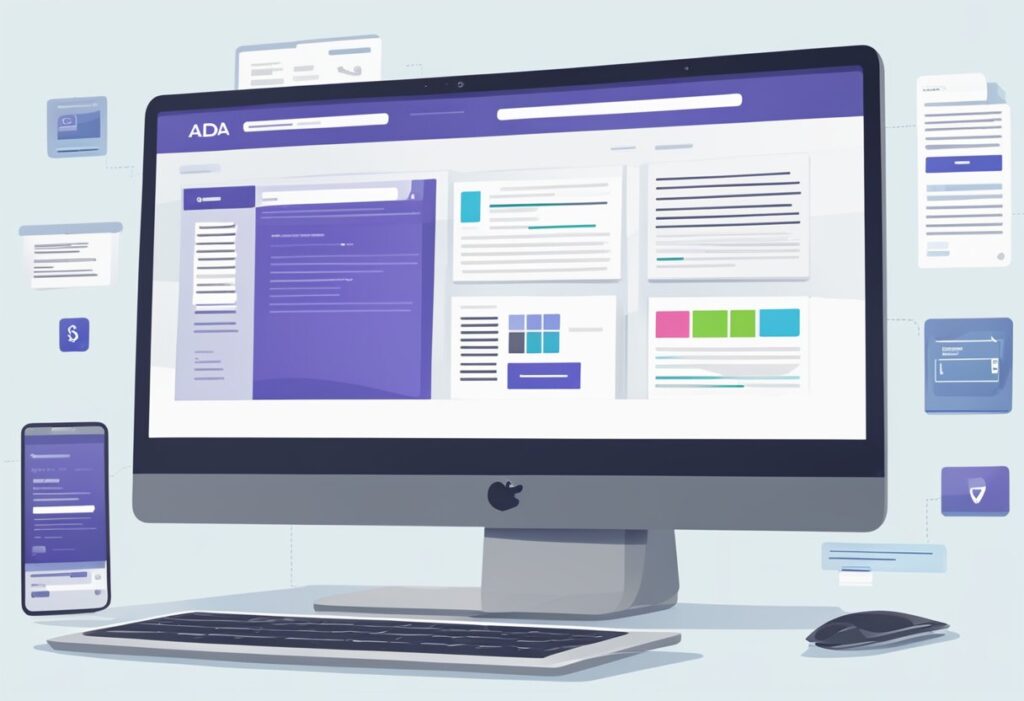In an increasingly digital age, the importance of web accessibility cannot be overstated. The Americans with Disabilities Act (ADA) requires certain businesses to make accommodations for people with disabilities, including in their online presence. Ensuring a website is ADA compliant not only meets legal standards but also opens up web content to millions of users with disabilities, fostering an inclusive environment and broadening a site’s audience. With a growing awareness of the need for equal access to web resources, it’s vital that website owners understand how to make their sites accessible to all.
The process of making a website ADA compliant involves adhering to the Web Content Accessibility Guidelines (WCAG), a set of recommendations for making web content more accessible to people with a wide range of disabilities. This includes accommodations for auditory, cognitive, neurological, physical, speech, and visual limitations. Taking proactive steps toward compliance mitigates legal risks, as non-compliance can result in significant penalties. Beyond this, there is a moral imperative to enhance website accessibility, ensuring that all users, regardless of ability, can engage with digital content.
Key Takeaways
- ADA compliance is crucial for creating an inclusive digital environment for all users.
- Complying with WCAG is key to aligning with ADA standards for web accessibility.
- Pursuing ADA compliance mitigates legal risks and broadens user accessibility.
Table of Contents
What Is ADA Website Compliance

ADA compliance refers to the accessibility of a website to individuals with disabilities, as mandated by the Americans with Disabilities Act. The goal is to ensure that web content is equally accessible to everyone, including those with impairments such as vision, hearing, motor, and cognitive difficulties.
Websites designed with ADA compliance in mind incorporate various features to improve usability for people with disabilities. For example:
- Text Content: Should be legible and compatible with screen readers.
- Multimedia: Alternatives like captions for videos and descriptions for images.
- Navigability: The site should be usable without a mouse, via keyboard-only navigation.
- Visibility: The use of contrasting colors and resizable text without loss of content.
- Predictability: Consistent navigation and identification of elements.
These features follow certain standards, mostly aligning with the Web Content Accessibility Guidelines (WCAG) which provide a series of recommendations for making web content more accessible.
ADA website compliance is not just a legal requirement for web presence of state and local governments and businesses serving the public; it is also a best practice for creating inclusive digital experiences for all users. Compliance is often evaluated through various tools and checklists available online such as the one detailed here, but may also involve manual review by accessibility experts.
Addressing ADA compliance helps to avoid legal repercussions, but more importantly, it provides a welcoming environment to a wider audience. When we make our digital content accessible, we are recognizing the importance of inclusivity and equality in our society.
To make a website ADA compliant, web developers and content creators should integrate accessibility considerations into the development process and perform regular audits to maintain compliance as web technologies and content evolve.
Web Content Accessibility Guidelines And ADA Compliance

The Web Content Accessibility Guidelines (WCAG) are central to building an ADA compliant website. They provide a structured set of guidelines for developers to follow ensuring their websites are accessible to all users, regardless of their abilities. These guidelines follow four key principles known as P.O.U.R. which stands for Perceivable, Operable, Understandable, and Robust.
Perceivable
Information and user interface components must be presentable to users in ways they can perceive. This means that no matter a user’s ability to sense, they must be able to receive the information being presented. This is largely achieved through the use of:
- Text Alternatives: Provide text alternatives for all non-text content.
- Images: Use alt tags to describe the purpose of an image.
- Videos and Audios: Offer captions and transcripts for multimedia.
- Adaptability: Create content that can be presented in different ways, such as with a simplified layout, without losing information.
- Distinguishability: Make it easier for users to see and hear content.
- Color Contrast: Ensure a high contrast ratio between text and background.
- Text Resize: Allow text to be resized up to 200% without loss of content or functionality.
Operable
User interface components and navigation must be operable. The goal is to ensure that all users can operate the interface, which often means providing alternatives to standard modes of operation.
- Keyboard Accessible: Ensure that all functionalities are operable through a keyboard interface.
- Enough Time: Give users sufficient time to read and use content.
- Seizures and Physical Reactions: Do not design content in a way that is known to cause seizures.
- Navigable: Help users navigate and find content.
- Consistent Navigation: Use consistent navigational mechanisms and naming conventions.
- Focus Order: Logical order of elements to be conducive to navigation via keyboard.
Understandable
Information and the operation of user interface must be understandable. This means that the content or the operation should not be beyond the user’s understanding.
- Readable: Make text content readable and understandable.
- Predictable: Web pages should appear and operate in predictable ways.
- Input Assistance: Offer help to users to avoid and correct mistakes.
Robust
Content must be robust enough to be reliably interpreted by a wide variety of user agents, including assistive technologies.
- Compatibility: Maximize compatibility with current and future user agents, including assistive technologies.
- Proper Markup: Use proper HTML tags to ensure elements are programmatically determined.
- Validation: Ensure that all markup is valid and can be reliably processed by user agents.
Adhering to these guidelines will put you on the path towards creating an ADA compliant website that is accessible to a wider range of users, reflecting a commitment to inclusivity and diversity in the digital space.
Assessing Your Website’s Compliance
When embarking on an ADA website audit, it’s crucial to ascertain how accessible your website is to individuals with disabilities. Doing so not only demonstrates a commitment to inclusivity but also aligns with legal standards. Utilize various tools and methods to effectively evaluate your site’s compliance.
Begin by using automated evaluation tools which scan your website and highlight issues that may hinder accessibility. For instance, a popular tool could help you assess your current website’s accessibility, pinpointing elements that need improvement. Automated checks are a starting point; they can detect blatant problems such as missing alt text for images or insufficient contrast on text.
Following this, manual testing is essential. Engaging real users with disabilities in the testing process can provide invaluable feedback on the user experience. This hands-on approach helps uncover nuanced accessibility barriers that automated tools might miss.
Create a checklist based on the Web Content Accessibility Guidelines (WCAG) to methodically review each element of your site. This should include:
- Textual Content: Verify legibility, font size, and the presence of alternative text for images.
- Navigability: Ensure logical structure and the ability to navigate via keyboard commands.
- Audio and Video: Check for closed captions and transcripts.
- Interactive Elements: Confirm that forms and calls-to-action are accessible.
Document every finding and prioritize issues based on their impact. This will guide you in creating an actionable plan to enhance your ADA visibility and ensure your website is not only compliant but also welcoming to all visitors.
Remediation And Consulting Services
Businesses seeking to align their websites with the Americans with Disabilities Act (ADA) can benefit greatly from dedicated remediation and consulting services. These services are designed to assess a website’s current accessibility status and then iteratively correct any issues through hands-on adjustments and code modifications. Expert advisors offer indispensable guidance, helping businesses tailor their approach to meet accessibility standards effectively and efficiently.
The initial phase typically begins with a comprehensive audit of the website, using both automated tools and manual evaluations. The results reveal specific areas of non-compliance with Web Content Accessibility Guidelines (WCAG). Following this review, remediation efforts commence. Here, specialized web developers address the identified shortcomings, which could range from semantic HTML fixes to more complex adjustments, ensuring screen readers and other assistive technologies can easily interpret and navigate the site.
Consulting services go a step further, offering ongoing support and strategy to maintain compliance. This might involve training for a company’s in-house developers, or consultation on incorporating accessibility into the corporate policy. Many services provide user testing, with feedback directly from individuals living with disabilities, to guarantee all changes enhance the actual user experience.
Pricing models for these services vary and they can be customized to fit the needs and budget of any business seeking compliance. Maintaining ADA compliance not only protects businesses from potential legal consequences but also expands their market by accommodating a broader audience. By investing in such services, companies demonstrate their commitment to inclusivity, while leveraging the expertise of professionals dedicated to making the web accessible for everyone.
Is Your Website ADA Compliant
Evaluating your website’s adherence to the Americans with Disabilities Act (ADA) is crucial to ensure accessibility for all users. The ADA mandates that all electronic and information technology, such as websites, must be accessible to people with disabilities. To determine if your website is compliant, consider the following factors:
- Textual Equivalence: All non-text content should have text alternatives. This includes images, audio files, and videos.
- Content Usability: The content must be navigable and understandable to all users, which often involves mindful organization and the use of clear language.
- Adaptive Strategies: The site should accommodate various assistive technologies and be usable across different devices and screen sizes.
- Consistent Navigation: Ensure that navigation within the website is consistent and predictable to aid users who rely on assistive technology.
- Keyboard Accessibility: All website functionality should be available from a keyboard for those unable to use a mouse.
Common Oversights in ADA Compliance:
- Inadequate alt text for images
- Complex tables that are difficult to interpret
- Videos lacking closed captioning or audio descriptions
- Insufficient contrast between text and background
- Inaccessible forms or navigation due to reliance on a mouse
To systematically evaluate your compliance:
- Review: Look through your site and check elements like alt-text, video captions, and tab navigation.
- Test: Use a variety of assistive technologies, such as screen readers, to test your site.
- Consult: Consider engaging with experts specializing in ADA compliant websites for professional evaluations and guidance.
It is essential to ensure your website not only meets current compliance standards but also maintains this status through consistent monitoring and updates. Making your website ADA compliant is not just a legal responsibility but a commitment to inclusivity and equal access for all users.
The Legal And Financial Risks Of Non-Compliance
Making a website ADA compliant is not only a matter of good practice but a legal requirement. Without adherence to the Americans with Disabilities Act (ADA), businesses expose themselves to significant legal and financial repercussions.
Legal Implications: Non-compliant websites may face legal action from individuals who find themselves unable to access services or information. Such lawsuits can lead to mandatory court appearances and may result in court-ordered compensation to affected parties. Moreover, businesses may be required to update their websites to meet compliance standards, potentially under strict court-imposed deadlines.
Financial Penalties: Initial fines for non-compliance can be considerable. Businesses may incur fines ranging from $55,000 to $75,000 for their first infraction. Should there be a subsequent violation, the penalties escalate sharply, with potential fines of up to $150,000. These are in addition to any legal fees and compensatory damages awarded as part of litigation.
- First Violation: $55,000 – $75,000
- Second Violation: Up to $150,000
These fines and penalties serve to underscore the importance of proactive compliance to avoid the crumbling effects such steep financial penalties can have on a business’s bottom line. Real-world examples show companies facing substantial losses not only in fines but also in revenue due to damaged reputation and consumer trust.
In summary, ADA compliance is a critical consideration for any business operating a website. The legal stakes and financial risks of overlooking ADA standards underscore the necessity of compliance. Ensuring accessibility is not only a moral imperative but a strategy to safeguard against legal action and financial loss.
Enhancing Accessibility And Inclusivity
Making your website ADA compliant transcends legal necessities, bringing significant advantages to both users and business owners. Compliance can lead to an enhanced experience for all customers, regardless of their abilities, ensuring that everyone can access and benefit from the website’s content and services.
User Experience
A website that caters to accessibility needs often results in a more streamlined and user-friendly interface. Enabling features such as keyboard navigation, alternate text for images, and sufficient contrast ratios not only assists individuals with disabilities but also creates a more intuitive experience for all users.
- Keyboard Navigation: Ensure that your site can be easily navigated using a keyboard alone.
- Alt Text for Visual Media: Provide text alternatives for any non-text content.
- Contrast Ratios: Use colors that have enough contrast between text and background.
Market Reach
An accessible website taps into a broader audience, including the 61 million adults in the United States living with a disability. By considering their needs, organizations can reach a wider demographic, potentially increasing their market share and customer base.
- Expand Audience: Connect with more people by accommodating diverse needs.
- Increase Engagement: Accessible sites tend to have lower bounce rates and longer visits.
Social Impact
Inclusivity on the web reflects a company’s commitment to corporate social responsibility. An ADA-compliant site sends a message of inclusivity and equality, enhancing the brand’s image and standing in the community.
- Brand Perception: Positive association with inclusiveness and social awareness.
- Community Standing: Higher respect and credibility within the diverse user community.
In conclusion, enhancing accessibility and inclusivity by complying with the ADA is a proactive step that signals a business’s commitment to equality. It is not only about adhering to standards but also about extending a welcome to all users, leading to a socially responsible and ethically sound online presence.
Conclusion: Taking Action Towards Compliance
Taking proactive steps to ensure that websites are ADA compliant is critical in fostering inclusivity online. Individuals with disabilities have the right to access digital content just as anyone else does. Web developers and site owners have both a moral and, often, legal obligation to work towards this goal.
To move forward with compliance, site owners should consider a free consultation or an ADA compliance scan. These resources are valuable in pinpointing any areas of a website that fall short of accessibility standards. By capitalizing on an expert analysis, adjustments can be made more efficiently, effectively aligning websites with ADA guidelines.
It is prudent to emphasize the importance of engaging professionals who specialize in ADA compliance. Their expertise can guide the enhancement of website features such as text-to-speech functionality, proper contrast ratios, and keyboard navigation capabilities. This ensures a thorough approach to compliance, covering all necessary accommodations.
Finally, maintaining an ongoing commitment to accessibility is crucial. ADA compliance is not a one-time task but a continuous process. As technology evolves, so too should accessibility features. By embracing this commitment, website owners contribute to a more inclusive internet—a place where differences in ability do not hinder access to information and services.
Site owners should take constructive steps now to enhance accessibility. This commitment not only safeguards against legal risks but also opens up digital platforms to a wider audience, both ethically and commercially enriching their web presence.
Frequently Asked Questions
The following subsections address common queries related to making a website ADA compliant, providing insights into testing, legal obligations, key features, and costs associated with ADA conformity.
How do I test my website for ADA compliance?
A website owner can test their website for ADA compliance by using automated tools that scan for accessibility issues, as well as conducting manual reviews to ensure it meets the Web Content Accessibility Guidelines (WCAG). Expert evaluations by accessibility specialists are also beneficial for a thorough assessment.
What are the legal requirements for an ADA compliant website?
The legal requirements for an ADA compliant website include conformance to the established WCAG 2.1 standards at Level AA, which ensures that content is accessible to people with a wide range of disabilities. This includes providing text alternatives for non-text content, sufficient contrast, keyboard navigation, and more.
What are the common features of an ADA compliant website?
Common features of an ADA compliant website often include text alternatives for images, video captioning, accessible navigation mechanisms, the use of ARIA labels for interactive elements, and content that can be presented in different ways without losing information.
How much does it typically cost to achieve ADA compliance for a website?
The cost to achieve ADA compliance for a website varies greatly depending on the complexity and size of the website. Small business sites may incur minimal costs if they implement accessibility from the start, while larger organizations may require significant investment to retrofit existing sites.
